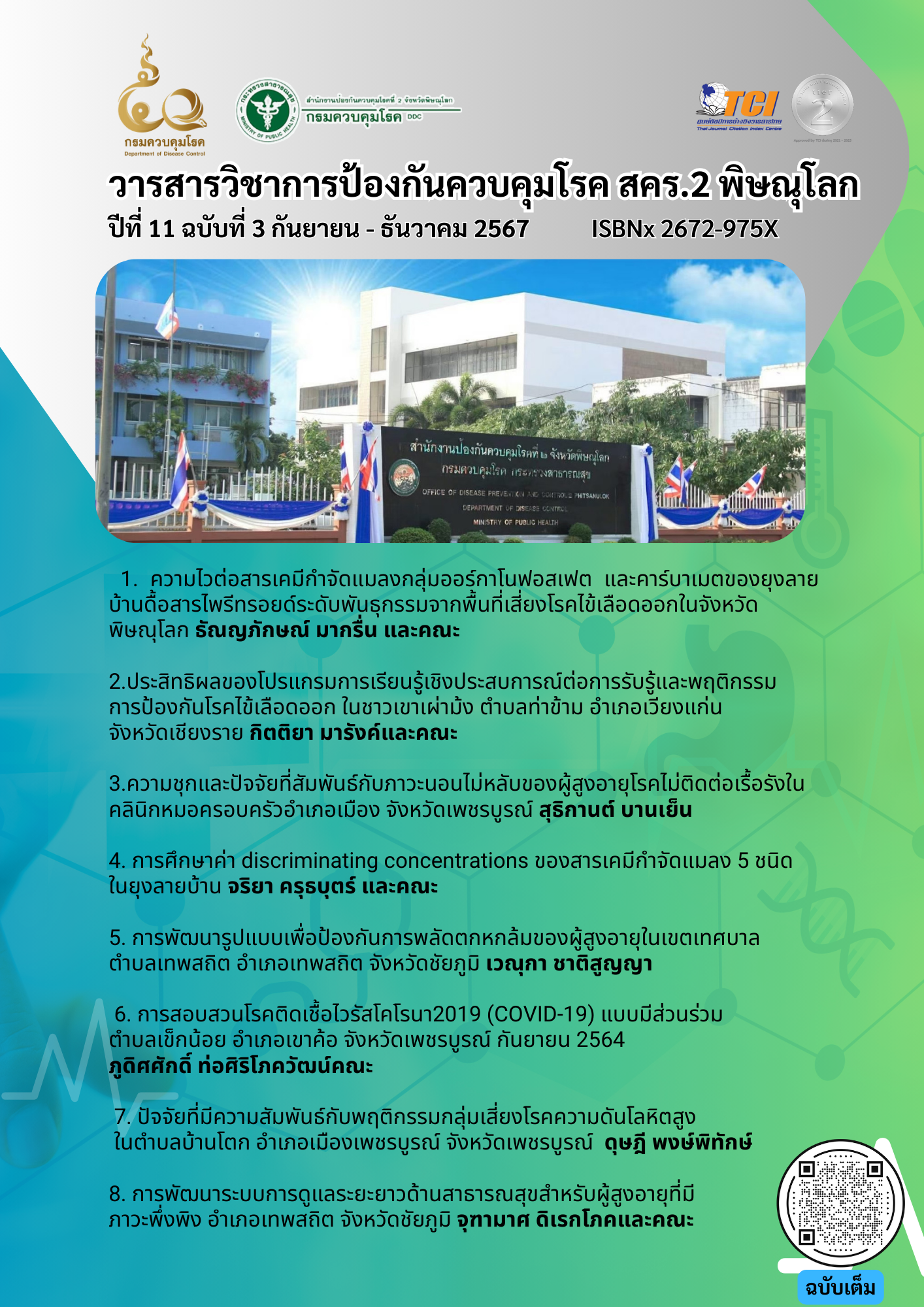4.การศึกษาค่า discriminating concentrations ของสารเคมีกำจัดแมลง 5 ชนิด ในยุงลายบ้าน
Main Article Content
บทคัดย่อ
การศึกษานี้มีวัตถุประสงค์เพื่อศึกษาค่า discriminating concentrations (DCs) ของ fipronil, bioresmethrin, d-trans allethrin, prallethrin และ s-bioallethrin และศึกษาความไวของยุงลายบ้านในพื้นที่ภาคสนามต่อสารเคมีกำจัดแมลงทั้ง 5 ชนิด ซึ่งการหาค่า DCs นั้นทำโดยการใช้ยุงลายบ้านที่มีความไวต่อสารเคมีกำจัดแมลงมาทดสอบหาค่าความเข้มข้นของสารเคมีกำจัดแมลงที่ทำให้ยุงตายร้อยละ 99 (LC99) ด้วยวิธีการทดสอบความไวต่อสารเคมีกำจัดแมลงขององค์การอนามัยโลก ซึ่งค่า DCs มีค่าเท่ากับ 2 x LC99 จากการศึกษาพบว่า discriminating concentrations ของ fipronil, bioresmethrin, d-trans allethrin, prallethrin และ s-bioallethrin อยู่ที่ร้อยละ 0.140, 0.674, 0.118, 0.084 และ 0.076 ตามลำดับ และเมื่อใช้สารในความเข้มข้นดังกล่าวมาทดสอบความไวกับยุงลายบ้านตัวเมีย รุ่น F1 จาก 9 จังหวัด ได้แก่ พิษณุโลก ชุมพร จันทบุรี กาญจนบุรี นครราชสีมา นครปฐม ลำพูน ตราด และมหาสารคาม พบว่า ค่าเฉลี่ยอัตราการตายของยุงที่สัมผัส fipronil, s-bioallethrin, d-trans allethrin, prallethrin และ bioresmethrin มีค่าเท่ากับร้อยละ 98.67±1.91, 24.56±19.51, 18.56±15.00, 17.67±12.77 และ 16.33±18.08 ตามลำดับ โดยมีความแตกต่างกันอย่างมีนัยสำคัญทางสถิติ (p<0.05) แสดงให้เห็นว่า ยุงจากพื้นที่ 9 จังหวัดข้างต้นยังมีความไวต่อ fipronil แต่มีความต้านทานต่อ s-bioallethrin, d-trans allethrin, prallethrin และ bioresmethrin ดังนั้นการใช้ fipronil จึงเป็นอีกทางเลือกหนึ่งที่สามารถใช้ในการควบคุมยุงลายบ้านที่ดื้อต่อสารไพรีทรอยด์ในพื้นที่ได้
Article Details

อนุญาตภายใต้เงื่อนไข Creative Commons Attribution-NonCommercial-NoDerivatives 4.0 International License.
ข้อลิขสิทธิ์วารสาร
บทความหรือข้อคิดเห็นใดๆ ที่ปรากฏในวารสารวิชาการป้องกันควบคุมโรค สคร. 2 พิษณุโลก เป็นวรรณกรรมของผู้เขียน กองบรรณาธิการวิชาการ และ สำนักงานป้องกันควบคุมโรคที่ 2 จังหวัดพิษณุโลกไม่จำเป็นต้องเห็นพ้องด้วยทั้งหมดหรือร่วมรับผืิดชอบใดๆ หากพบว่าบทความของท่านมีการคัดลอกผลงานทางวิชาการ (plagiarism) มากกว่า 25 เปอร์เซ็นวารสารขอปฏิเสธการตีพิมพ์เผยแพร่ทุกกรณี วิธีตรวจสอบการคัดลอกผลงานทางวิชาการ (plagiarism)
เอกสารอ้างอิง
กองโรคติดต่อนำโดยแมลง กรมควบคุมโรค. รายงานประจำปี 2565 กองโรคติดต่อนำโดยแมลง. นนทบุรี: กรมควบคุมโรค กระทรวงสาธารณสุข; 2565.
ราชวิทยาลัยกุมารแพทย์แห่งประเทศไทย. แนวทางเวชปฏิบัติการดูแลรักษาผู้ป่วยเด็กที่สงสัยภาวะติดเชื้อไวรัสซิกาแต่กำเนิด [อินเทอร์เน็ต]. 2559 [เข้าถึงเมื่อ 1 ก.พ. 2566]; เข้าถึงได้จาก: https://mis.nkp-hospital.go.th/institute/admInstitute/nFile/20161219-105941.pdf.
World Health Organization. Dengue: Guidelines for diagnosis, treatment, prevention and control. Genève, Switzerland: World Health Organization; 2009.
World Health Organization. Vector control operations framework for Zika virus [Internet]. 2016 [cited 2023 Feb 16]; Available from: https://iris.who.int/bitstream/handle/10665/207481/WHO_ZIKV_VC_16.4_eng.pdf?sequence=1.
World Health Organization. Pesticides and their application for the control of vectors and pests of public health importance. 6th ed. Genève, Switzerland: World Health Organization; 2006.
สำนักโรคติดต่อนําโดยแมลง กรมควบคุมโรค. คู่มือวิชาการโรคติดเชื้อเดงกีและโรคไข้เลือดออกเดงกีด้านการแพทย์และสาธารณสุข ปี พ.ศ. 2558. พิมพ์ครั้งที่ 1. กรุงเทพมหานคร: อักษรกราฟฟิคแอนด์ดีไซน์; 2558.
Insecticide Resistance Action Committee. Prevention and Management of Insecticide Resistance in Vectors of Public Health Importance. [Internet]. 2011 [cited 2023 Nov 4]; Available from: https://croplife.org/wp-content/uploads/pdf_files/IRAC-Prevention-management-of-insecticide-resistance-in-vectors-pests-of-public-health-importance.pdf.
สิริภัค สุระพร. กลไกที่แมลงต้านทานต่อสารฆ่าแมลง. วารสารเกษตรพระวรุณ. 2562;16(1):34-48.
ขนิษฐา ปานแก้ว, บุษราคัม สินาคม, พรพิมล ประดิษฐ์, บุญเสริม อ่วมอ่อง. การศึกษาความไวต่อสารเคมีและสารเสริมฤทธิ์ของยุงลาย Aedes aegypti ในประเทศไทย ปี พ.ศ. 2562. วารสารวิชาการป้องกันควบคุมโรค สคร. 2 พิษณุโลก. 2564;8(1):69-83.
บุญเสริม อ่วมอ่อง, สงคราม งามปฐม, มาโนช ศรีแก้ว. การศึกษาความไวของยุงลาย Aedes aegypti ต่อสารกำจัดแมลงในภาคกลางของประเทศไทย. วารสารกระทรวงสาธารณสุข. 2542;18(7-12):93-101.
Jirakanjanakit N, Rongnoparut P, Saengtharatip S, Chareonviriyaphap T, Duchon S, Bellec C, et al. Insecticide susceptible/resistance status in Aedes (Stegomyia) aegypti and Aedes (Stegomyia) albopictus (Diptera: Culicidae) in Thailand during 2003-2005. J Econ Entomol. 2007;100(2):545-50.
World Health Organization. Standard operating procedure for testing insecticide susceptibility of adult mosquitoes in WHO tube tests. Genève, Switzerland: World Health Organization; 2022.
Capinera JL. Abbott's Formula. Encyclopedia of entomology. [Internet]. 2005 [cited 2023 Nov 5]; Available from: https://link.springer.com/referenceworkentry/10.1007%2F0-306-48380-7_4.
World Health Organization. Test procedures for insecticide resistance monitoring in malaria vector mosquitoes. 2nd ed. Geneva, Switzerland: World Health Organization; 2016.
กาญจนา โกติทิพย์, เจนจิรา จันสุภา, สุธาสินี มาแดง, กานต์ธีรา เรืองเจริญ, วรรณภา สุวรรณเกิด. ความไวของยุงลายบ้าน (Aedes aegypti) ต่อสารเคมีกลุ่ม Pyrethriod ในพื้นที่ 8 จังหวัด ภาคเหนือ ปี 2558 และ 2559. วารสารสาธารณสุขล้านนา. 2561;14(1):13-22.
ผไทมาศ เปรื่องปรีชาศักดิ์, จักรพงษ์ วงษ์งาม, สามิตร พันทะลัย, สุริยันต์ โสภาวัฒน์, ศักดิ์ชาย ศิริกันรัตน์, ปราโมทย์ บุญแก้ว. การทดสอบประสิทธิภาพของสารเคมีกำจัดยุงลายโดยการพ่นหมอกควันในพื้นที่จังหวัดเลยและหนองบัวลำภู ปี 2565. วารสารวิชาการสำนักงานป้องกันควบคุมโรคที่ 8 จังหวัดอุดรธานี. 2566;2(1):1-13.
Khan MA, Riaz M, Kamran M, Shad SA. Unstable fipronil resistance associated with fitness costs in fipronil-selected Aedes aegypti L. Exp Parasitol. 2023;250:108543.
Fankhauser B, Dumont P, Hunter JS, McCall JW, Kaufmann C, Mathis A, et al. Repellent and insecticidal efficacy of a new combination of fipronil and permethrin against three mosquito species (Aedes albopictus, Aedes aegypti and Culex pipiens) on dogs. Parasites & Vectors. 2015;8(1):64.
Ratisupakorn S, Lorn S, Dada N, Ngampongsai A, Chaivisit P, Ritthison W, et al. Aedes Albopictus (Diptera: Culicidae) Susceptibility Status to Agrochemical Insecticides Used in Durian Planting Systems in Southern Thailand. J Med Entomol. 2020;58(3):1270-9.


